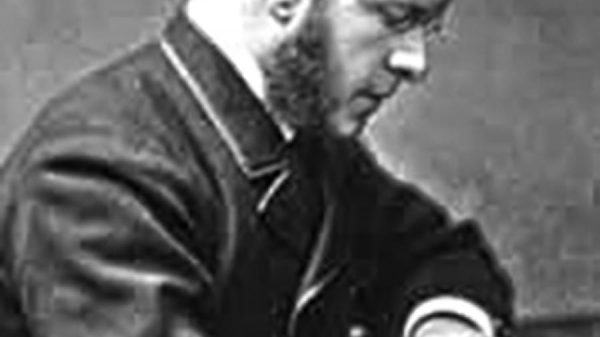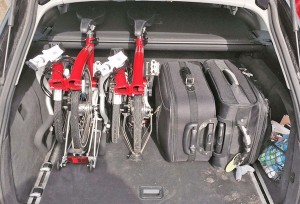Marks & Spencer has long been one of the most cherished names to grace the high streets of Leeds city centre. As our vibrant city expands and develops with more brands appearing in new developments such as Trinity and the up and coming Victoria Gate, we take a look at the company from its humble beginnings in the historical Kirkgate Market, on its incredible journey to the global brand it is today.
The Beginning
Michael Marks, a Jewish immigrant came to Leeds from Slonim, Belarus in around 1882. He started work as a pedlar and soon had enough capital with the help of warehouse owner Isaac Dewhurst, to open a stall in Kirkgate Market. Initially, Marks sold items widely varying in price, but with the penny section proving to be far more popular he stopped selling the more costly products. This change in merchandise enabled Marks to put up the poster with the now famous slogan “Don’t Ask the Price, It’s a Penny.” Popular items selling at the penny price included combs, buttons and yo-yos.
The business was growing and as a result, Marks decided he needed a business partner in order to expand further. His first offer went to Isaac Dewhurst but he declined and instead recommended his senior cashier Tom Spencer. Originally from Skipton, Tom was a plain speaking, practical Yorkshireman who was said to be good natured yet loud and burly in contrast to Michael. On 28th September 1894, Marks & Spencer was born when Tom invested £300 into the company and became the official partner. The two men each brought their own skills to the table – Mark’s flair for dealing with customers, buying and selling merchandise, and Spencer’s ability in dealing with administration and accounts. Despite their differing backgrounds and personalities, the two men liked each other and made a great team.
The Marks & Spencer ‘Penny Bazaars’ flourished and by 1900 there were 36 Bazaars and 12 high street stores open. Much of this early success can be attributed to a successful marketing ploy that the partners employed. Adding the words “Admission Free” to the popular penny price slogan encouraged customers to browse the products without obligation to buy which was relatively unheard of at this time.
War And Change
The early 20th century brought a time of vast change to M&S. In 1903, it became a limited company and Tom Spencer retired to pursue his dream of becoming a farmer. He died two years later and his shares passed to his legal administrator William Chapman.
In 1904 a Penny Bazaar was opened in the brand new Cross Arcade on Boar Lane, taking up eight units. Michael Marks passed away on New Year’s Eve of 1907. He was remembered as a great philanthropist and attendance at his funeral, held at Manchester Jewish cemetery was the largest known there. His shares were held in trust until his son Simon came of age, so William Chapman became the chairman of the company.
Marks & Spencer was an innovative company with open displays, self-selection and browsing catering to people who were able to buy more with the rising incomes and improved living conditions that this time brought. Popular stock at this time were socks, combs, sewing implements and biscuits. One of the most popular was sheet music – this was still a time before TV and radio when families would gather around the piano after dinner for evening entertainment. M&S sold the latest compositions- all for a penny of course!
In 1912 Simon Marks was a junior director working under Chapman but the men had differing opinions on the running of the company, eventually leading to a court battle which settled in Simon’s favour. He became chairman at just 28 years old during the First World War, a difficult time for the whole country. Marks & Spencer by this time had 145 stores but the age of the Penny Bazaars had to end as the War meant goods were scarce and prices shot up drastically. Sales of buttons, needles and thread soared however in the need to make do with what you already had.
In the Great Depression between the wars, the company needed to adapt in the face of shortages, high unemployment levels and greater competition from other variety stores. Reducing the wide range of stock to two main departments – food and clothing, whilst expanding the pricing up to 5 shillings was how M&S responded. Always at the forefront of innovation, M&S was the first company to pre-test the quality of their goods and fabrics in their own research lab. The brand started to become synonymous for high quality at lower prices. Items such as tea sets and other affordable household goods were also on offer as demand rose.
One employee at this time was Katherine Heseltine. She began work as a sales assistant at the Harrogate store during her teens in 1926. Her duties over the years included being on fire watch during WW2! Katherine remained with M&S for nearly 50 years finally retiring in 1974.
Perhaps one of the reasons for staff staying with the company for so long was the focus on human relations (the first recorded Long Service Award was handed out in 1918 for 25yrs. The staff member was awarded a gold watch and £200). From the inception of the company, Marks had always cared for the welfare of his staff, providing wooden boxes to stand on so that the girl’s feet did not get cold, and giving out Christmas presents. In 1933 M&S established the most comprehensive Staff Welfare Service of its kind with the help of Flora Solomon.
Flora was born into a wealthy Russian family and included famous people from the arts and political circles among her friends. She discussed employee welfare standards with Simon during a chance meeting at a dinner party, and he gave her the task of creating the welfare department. New services she introduced included health and dental care, camping holidays and subsidised staff canteens.
Staff clearly appreciated the welfare service with Betty remembering “My aunt worked at M&S Oxford Street branch in late 1940’s/early 1950’s and told me about services for staff including chiropody, hairdressing and being given proper hankies if they had a cold etc. They had much better conditions than many of the assistants in other stores and felt well cared for.”
The following year Flora also set up the Training Department. Her aim was to develop team spirit and help employees learn new skills, saying “A store is not a collection of private individuals, but a team of people working for a common object….The well-being of an individual cannot exist in a vacuum.” Flora eventually received an OBE for organising food distribution and helping to evacuate Jewish children from Europe during WW2. She was also the mother of Peter Benenson, founder of Amnesty International.
In 1938 the Rialto Cinema on Briggate was demolished to make way for a new M&S store but the Ministry of Works took over the building to use as storage and an air-raid shelter in the basement. The outbreak of WW2 brought more changes. ‘Restriction Orders’ were introduced with limits on how civilian clothing could be made to make the most of what little was available. Clothing had to be made using only 5 buttons, 2 pockets and 4 metres of stitching per item! People started to eat out more as ration tokens were not required for restaurants. This meant that by 1942 M&S had 82 café bars in the stores. The company tried to ‘do their bit’ taking part in fire watching, setting up soup kitchens and even raised money for a Spitfire.
Over 100 M&S stores were bombed, 16 of them destroyed completely. Ralph Salaman was the Senior Air Raid Patrol Officer for Marks & Spencer during the war. This was a difficult job and his duties included visiting every store that had been hit by bombs. At the Head Office he once demonstrated the 6th floor rope fire escape personally. By all accounts his demonstration did not go entirely smoothly with him saying “I fell into the mews behind. I didn’t hurt myself but put my foot through two windows on the way down.”
Peaceful Times
The next couple of decades following the war showed that despite continued rationing, people were developing a love of fashion – and not just the wealthy. In order for stylish clothing to be accessible to all, it needed to be practical. M&S took a man-made fabric they had designed during the war, changed its name to Marspun and began creating Parisian inspired dresses with it. The ‘New Look Dress’ created in 1955 was a highly popular dress based on a collection by Christian Dior. This dress went against the utility clothing regulations as it used a lavish amount of material. The President of the Board of Trade said at the time “There should be a law against it.”
The 1950’s also saw a revolution in the sales of bras. Hard for us to imagine today, bras were sold in only one cup size with retailers failing to notice that women came in all shapes and sizes! M&S ‘broke the mould’ in 1951 and began selling bras with small, medium and large cups. By 1953 they were selling over 120,000 a week!
A customer of the time, Maggs, remembers “I remember mum taking me to M&S in Darlington where I was measured for my first bra. How grown up and embarrassed I felt!”
This new fashion age continued into the 1960’s with Twiggy first modelling for M&S in 1966. Aged just 16 she became known as the world’s first supermodel and has since remained synonymous with the company, representing the timeless face of M&S and its changing fashions for many customers.
Simon Marks had died in 1964 passing the Chairman’s baton to Israel Sieff, his closest childhood friend and right hand man in the company for many years. Israel’s younger brother Teddy took over as chairman 3 years later until 1972. During his time the company profits and sales nearly doubled.
Fashion was not the only object of M&S innovation. Until the end of the 60’s, due to concerns about food poisoning and bacteria all their meat had been sold frozen. M&S invented the ‘cold-chain’ process ensuring that chicken was kept at 4 degrees centigrade constantly and customers were then able to purchase fresh produce.
Lifestyles were changing with more women going out to work in the 1970’s and beyond, so the food department became even more important by providing boil-in-the-bag and microwave meals. Indian and Chinese meals were available, and M&S became the first retailer to use sell-by dates on their food.
Food has continued to be an important part of Marks & Spencer over recent years with famous deserts such as the melting middle chocolate pudding. The company have become increasingly popular for the high quality, easy food they sell. One character in particular has proved to be the nation’s favourite – Percy Pig! First sold in 1993, there are now over 10 million bags of the sweets sold each year. He even has well in excess of 200,000 Facebook fans!
One Percy fan Ellie says “I remember the first time my mum gave me Percy Pigs in my lunch box. Best day at school EVER.”
Clothing wise, M&S branched out and began collaborating with famous designers such as George Davies and Paul Smith. Over recent decades exciting lines such as Per Una and Autograph appeared, and the company work hard to remain at the forefront of fashion.
Heritage and Archives
Today, M&S are proud of their heritage, and rightly so. The Michael Marks building at Leeds University is home to the M&S Company Archive. Open to the public, the archive has a collection of over 70,000 historic items from staff records, photographs to packaging and clothing created by the company over years gone by. There is a permanent exhibition called ‘Marks in Time’ which celebrates the role that M&S has played in people’s lives since 1884. As well as the permanent exhibition, there is a heritage trail that you can walk through Leeds city centre taking in all the places that form a part of the company’s history – from its humble beginnings at Kirkgate Market with the famous Marks & Spencer clock to the archives building.
There are also regular events organised by the archives. One such event that took place recently was the Museums at Night Marks In Time Live: After Hours. Held in Leeds Kirkgate Market, the free event took visitors on a journey back in time to the early days of M&S. Accompanied by talented musicians playing original music from the early 20th century were four actors portraying some important characters from M&S past – Michael Marks, Esther Brown one of the original shop girls, Simon Marks and Flora Solomon. In between performances, guests could enjoy tea and cake served in the vintage tea room. The evening was a fantastic success and thoroughly enjoyed by all who visited. There are always a good variety of events taking place throughout the year, which are advertised on their website.
With Marks & Spencer just releasing their results for the last tax year showing a pre-tax profit up by 6.1%, with food sales exceeding expectations in a difficult market, we are sure the company will continue to go from strength to strength after a challenging few years. Their new business strategy, teamed with Plan A (a 100 point eco-plan to ensure they as a company target climate change and waste along with their original principles) will mean M&S remain at the forefront of innovation and integrity for many more years to come.
For more information on the M&S Company Archives, including details of upcoming events, please visit their website www.marksintime.marksandspencer.com







